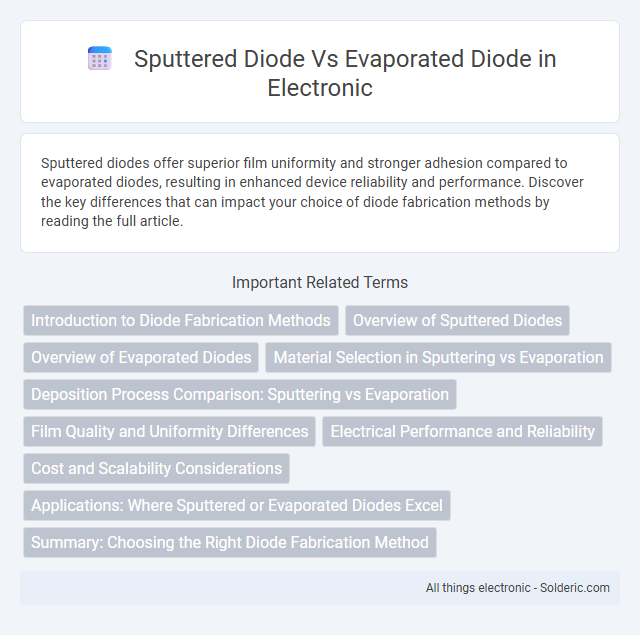Sputtered diodes offer superior film uniformity and stronger adhesion compared to evaporated diodes, resulting in enhanced device reliability and performance. Discover the key differences that can impact your choice of diode fabrication methods by reading the full article.
Comparison Table
| Feature | Sputtered Diode | Evaporated Diode |
|---|---|---|
| Deposition Method | Physical sputtering (ion bombardment) | Thermal evaporation (vapor condensation) |
| Film Uniformity | High uniformity and density | Moderate uniformity, less dense films |
| Adhesion | Excellent adhesion to substrate | Weaker adhesion compared to sputtering |
| Process Temperature | Often done at lower temperatures | Requires higher substrate temperature |
| Material Utilization | Lower material usage efficiency | Higher material utilization |
| Film Stress | Lower intrinsic stress | Higher intrinsic stress |
| Applications | High-performance diodes requiring durability | Cost-effective, simple diode fabrication |
| Cost | Generally higher due to equipment and process | Lower overall manufacturing cost |
Introduction to Diode Fabrication Methods
Sputtered diodes and evaporated diodes differ primarily in their thin-film deposition techniques used during fabrication, impacting device performance and reliability. Sputtering involves ejecting material from a target by ion bombardment, producing dense, uniform films with strong adhesion, while evaporation relies on thermal vaporization of materials to form thin films, often resulting in faster deposition but less uniformity. Understanding these fabrication methods helps you select the optimal diode type tailored to specific electronic applications and performance requirements.
Overview of Sputtered Diodes
Sputtered diodes are formed using a physical vapor deposition process where ions bombard a target material to deposit thin films with high uniformity and strong adhesion. This method typically results in diodes with superior electrical performance, including improved consistency in current flow and enhanced durability compared to evaporated diodes, which rely on thermal evaporation of materials. Your choice of sputtered diodes ensures better device reliability and stability in high-frequency and high-power applications.
Overview of Evaporated Diodes
Evaporated diodes are created using physical vapor deposition, where a material is heated until it vaporizes and then condenses onto a substrate forming a thin, uniform layer. This method allows precise control over film thickness and composition, making evaporated diodes ideal for applications requiring high purity and smooth interfaces. Compared to sputtered diodes, evaporated diodes typically exhibit reduced defect density and improved electrical performance due to the gentler deposition process.
Material Selection in Sputtering vs Evaporation
Material selection in sputtering offers greater versatility, allowing metals, alloys, and even oxides to be deposited with uniform thickness and enhanced adhesion on various substrates. Evaporation typically involves materials with lower melting points, limiting your options to metals that vaporize easily, which can affect film density and performance. Choosing sputtering enables precise control over stoichiometry and film properties, critical for advanced diode applications requiring consistent electrical characteristics.
Deposition Process Comparison: Sputtering vs Evaporation
Sputtered diodes utilize a physical vapor deposition process where high-energy ions eject target material onto the substrate, resulting in dense, uniform thin films with excellent adhesion and better step coverage compared to evaporated diodes. Evaporated diodes rely on thermal evaporation, where the material is heated until it vaporizes and deposits onto the substrate, typically producing films with higher purity but potentially less conformality and adhesion. Choosing between sputtered and evaporated diodes depends on your specific application requirements for film density, uniformity, and substrate coverage.
Film Quality and Uniformity Differences
Sputtered diodes exhibit superior film quality and uniformity compared to evaporated diodes due to the higher energy of incoming atoms, which promotes dense, adherent layers with fewer voids and defects. The sputtering process enables better control over film thickness and composition, resulting in more consistent electrical characteristics across large substrates. In contrast, evaporated diodes often suffer from non-uniform deposition and lower film density, affecting device performance and reliability.
Electrical Performance and Reliability
Sputtered diodes exhibit superior electrical performance due to their dense, uniform thin films, which result in lower resistivity and enhanced current conduction compared to evaporated diodes. Their reliability is also higher, as sputtering creates strong adhesion and fewer defects, reducing the risk of degradation over time under thermal and mechanical stress. Your device's efficiency and lifespan can significantly benefit from choosing sputtered diodes for applications demanding consistent electrical properties and long-term stability.
Cost and Scalability Considerations
Sputtered diodes generally offer higher scalability for large-area applications due to their uniform film deposition and compatibility with automated processes, making them cost-effective for mass production. Evaporated diodes often incur lower initial equipment costs but face challenges in scaling up because of non-uniform coatings and slower throughput, which can increase per-unit manufacturing expenses. Cost efficiency in sputtered diodes improves significantly at scale, while evaporated diodes remain more suitable for small-batch or custom production runs.
Applications: Where Sputtered or Evaporated Diodes Excel
Sputtered diodes excel in high-performance applications requiring superior film adhesion and uniformity, such as in advanced sensors, high-frequency devices, and flexible electronics. Evaporated diodes are preferred in cost-sensitive, large-area applications like photovoltaic cells and basic optoelectronics due to their faster deposition rates and simpler process. Both methods serve distinct roles: sputtering offers enhanced material density and durability, while evaporation excels in scalability and throughput.
Summary: Choosing the Right Diode Fabrication Method
Sputtered diodes offer superior film uniformity and adhesion, enhancing device reliability in high-performance applications. Evaporated diodes enable faster deposition rates with lower equipment costs, ideal for large-scale or cost-sensitive production. Selecting the appropriate diode fabrication method depends on balancing performance requirements, production volume, and budget constraints.
Sputtered diode vs evaporated diode Infographic

 solderic.com
solderic.com